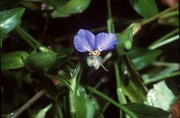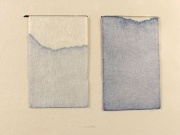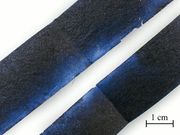Difference between revisions of "Dayflower blue"
Jump to navigation
Jump to search
| Line 1: | Line 1: | ||
[[File:dayflowerbpd1.jpg|thumb|Asiatic dayflower (Commelina communis)]] | [[File:dayflowerbpd1.jpg|thumb|Asiatic dayflower (Commelina communis)]] | ||
== Description == | == Description == | ||
| − | + | [[File:dayflower blue.jpg|thumb|Paper dyed with dayflower blue]] | |
A blue dye extracted from the petals of the ''Commelina communis'' lily plant native to Asia. The blue colorant in the dayflower blue dye is primarily commelinin. | A blue dye extracted from the petals of the ''Commelina communis'' lily plant native to Asia. The blue colorant in the dayflower blue dye is primarily commelinin. | ||
| Line 9: | Line 9: | ||
tsuyukusa (Jap.); aigami (Jap.); commelinin; Commelina communis (Asiatic dayflower) | tsuyukusa (Jap.); aigami (Jap.); commelinin; Commelina communis (Asiatic dayflower) | ||
| − | [[File: | + | [[File:Dayflower blue_dyed paper2.jpg|thumb|Paper dyed with dayflower blue]] |
== Physical and Chemical Properties == | == Physical and Chemical Properties == | ||
ISO R105 Lightfastness Classification = | ISO R105 Lightfastness Classification = | ||
| − | == | + | == Resources and Citations == |
* S.Shimoyama, Y.Noda, S.Katshuhara, "Non-Destructive Analysis of Ukiyo-E Prints" ''Dyes in History and Archaeology'', No.15, Paper presented in Manchester England, Nov. 1996. | * S.Shimoyama, Y.Noda, S.Katshuhara, "Non-Destructive Analysis of Ukiyo-E Prints" ''Dyes in History and Archaeology'', No.15, Paper presented in Manchester England, Nov. 1996. | ||
| − | |||
| − | |||
| − | |||
| − | |||
| − | |||
| − | |||
| − | |||
| − | |||
| − | |||
* R.Feller, M.Curran, C.Bailie, 'Identification of Traditional Organic Colorants Employed in Japanese Prints and Determination of their Rates of Fading', ''Japanese Woodblock Prints'', Allen Memorial Art Museum, Oberlin College, Oberlin, 1984 | * R.Feller, M.Curran, C.Bailie, 'Identification of Traditional Organic Colorants Employed in Japanese Prints and Determination of their Rates of Fading', ''Japanese Woodblock Prints'', Allen Memorial Art Museum, Oberlin College, Oberlin, 1984 | ||
| − | |||
[[Category:Materials database]] | [[Category:Materials database]] | ||
Revision as of 14:02, 30 June 2020
Description
A blue dye extracted from the petals of the Commelina communis lily plant native to Asia. The blue colorant in the dayflower blue dye is primarily commelinin.
- See also [Uemera Dye Archive (Tsuki kusa)]
Synonyms and Related Terms
tsuyukusa (Jap.); aigami (Jap.); commelinin; Commelina communis (Asiatic dayflower)
Physical and Chemical Properties
ISO R105 Lightfastness Classification =
Resources and Citations
- S.Shimoyama, Y.Noda, S.Katshuhara, "Non-Destructive Analysis of Ukiyo-E Prints" Dyes in History and Archaeology, No.15, Paper presented in Manchester England, Nov. 1996.
- R.Feller, M.Curran, C.Bailie, 'Identification of Traditional Organic Colorants Employed in Japanese Prints and Determination of their Rates of Fading', Japanese Woodblock Prints, Allen Memorial Art Museum, Oberlin College, Oberlin, 1984


